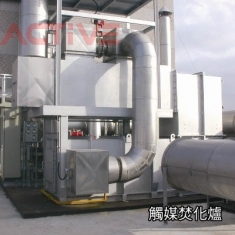Environmental System

Case study
This case is applicable for fuel cell plants. These plants include facilities such as system windmill, catalytic incinerator, heat exchanger, incinerator windmill and other instrumentation.
The system is designed with DP transmitters so that the pressure at the front end can be stabilized, preventing it from the disruption of VOC pollution control facilities. Wind test equipments are installed to check if both of the windmills are working properly. In case one of them does not function normally, another one will be ready as replacement to ensure the operation is stable.
Since there is no poisonous, harmful gaseous contained in the exhaust emitted from the system, the catalytic incinerator is employed to lower the activation energy for exhaust incineration. By working with a heat exchanger, we can greatly lower the fuel consumption of the incineration system and thus reach the goal for saving the energy.
There are bypassing circuit and temperature control installed for the system for safety concern. When the concentration of the exhaust is overly high during entry, the temperature control mechanism will be alarmed and activate the bypassing circuit to avoid the excessively high temperature of the incineration system itself while protecting the catalyst.
| Process: | VOC Control for Polymer Cell Plant |
|---|---|
| VOC abatement system: | Catalytic thermal oxidizer with heat exchanger |
| Process exhaust flowrate: | 4,927 Nm3/hr |
| Exhaust component:Methanol | 2021 mg/Nm3 |
| NMP | 606 mg/Nm3 |
| Acetone | 5458 mg/Nm3 |
| Total | 8085 mg/Nm3 |
| Process inlet temp.: | 25 ℃ |
| Heat exchanger cold side inlet/Outlet: | 25℃/328℃ |
| Heat exchanger hot side inlet/Outlet: | 470℃/180℃ |
| Exhaust Temperature:(MAX.) | 180~240 ℃ |
| DRE (Destruction Removal Efficiency):Organics | ≧ 95% |


